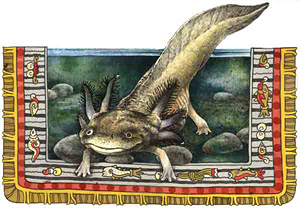 |
 |
 |
 Editorials | Environmental | February 2007 Editorials | Environmental | February 2007  
New Rules Protect Animals Hurt by Climate Change
 Guillermina Guillén - El Universal Guillermina Guillén - El Universal


| | The ajolote, a salamander-like amphibian that makes its home in the waters of Xochimilco in Mexico City, will join the list of protected species. |
A group of edible, but endangered, animals will soon be federally protected under new regulations announced by the National Commission for Protected Natural Areas (CONANP). The new rules affect species that CONANP says face possible extinction due to the wide-ranging effects of climate change.

Among the newly protected animals are spider and howler monkeys that are often used in exotic dishes in the state of Veracruz and in the country´s interior.

The ajolote, a salamander-like amphibian that makes its home in the waters of Xochimilco in Mexico City, will join the list of protected species, helped along by a United Kingdom-sponsored conservation program already in place.

The project will receive a budget 10 times greater than that of previous years and include some desert fish endemic to Mexico that live in springs, CONANP said. Increased droughts are putting these species at risk.

Ernesto Enkerlin, the director of CONANP, told EL UNIVERSAL that Mexico has many species that need protection, but it would be difficult to incorporate all of them into the conservation program.

Priorities have been defined, he explained, and the ajolote was chosen because amphibians are highly susceptible to climactic changes and extinction.

"They are very characteristic of Mexico, and are also a good indicator of the health of bodies of water. Therefore, it´s important to have this conservation project, they are part of tradition."

Ajolotes were considered a delicacy during the pre-Hispanic period, said Francisco Romero of the Wild Fauna Ecology and Conservation Department at the Xochimilco campus of the National Autonomous University of Mexico.

Nowadays, however, people don´t find them as appetizing because they live in treated water coming from a plant in Cerro de la Estrella in the Iztapalapa district.

"They once lived in pure water, in springs, and now everything is the opposite. But incredibly, they continue to live," he said. | 
 | |
 |



